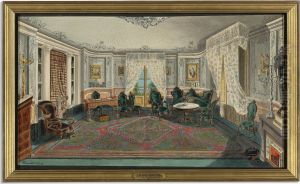Julius Minutoli Paintings
Julius Heinrich Peter Philipp von Minutoli was a Prussian chief of police, diplomat, explorer, and art collector. Born on March 12, 1804, in Berlin, Minutoli came from a family of Swiss origin. His father, Heinrich Menu von Minutoli, was also an influential figure who served as the police president of Berlin.
Minutoli's career was multifaceted. Initially, he studied law and embarked on a career in the Prussian civil service. He rose to prominence in the police service, becoming the chief of police in Berlin, but his interests extended beyond law enforcement. Minutoli was a man of the Enlightenment, with a keen interest in archaeology, ethnology, and art. His travels, particularly to the Middle East, were driven by a desire to understand different cultures and to collect artifacts and art pieces.
In 1827, Minutoli embarked on an expedition to Egypt and Sudan, aiming to explore ancient sites and collect artifacts for the newly founded Berlin Museum. This journey was significant not only for Minutoli's personal ambitions but also for the field of Egyptology. He was one of the early European explorers who contributed to the study of ancient Egyptian civilization.
Minutoli's art collection grew over the years, and he became known for his discerning taste and the diversity of his acquisitions. He collected not just European art but also artifacts from Africa and Asia, reflecting his broad interests in world cultures.
Despite his contributions to archaeology and art, Minutoli's career had its share of controversies, particularly in his role as a police chief. His tenure was marked by a strict law enforcement approach, which sometimes put him at odds with public opinion and political figures of the time.
Julius von Minutoli died on September 17, 1860, in Lausanne, Switzerland. Although not as widely remembered as some of his contemporaries, his work in the field of archaeology and his contributions as a collector have left a lasting impact. His legacy is preserved in the collections he helped to build and in the historical record of 19th-century European exploration and cultural exchange.
